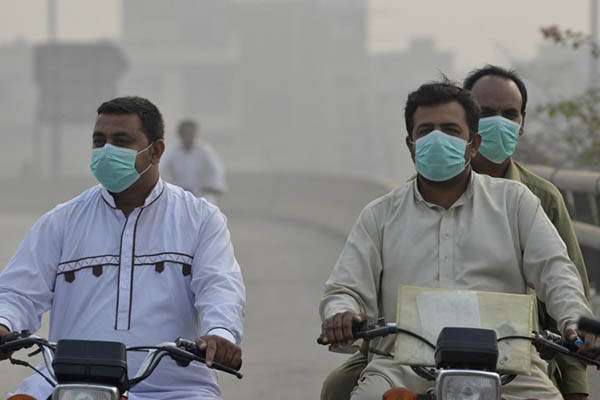
File photo. Arif Ali—AFP
Lahore’s ‘hazardous’ air quality raises health concerns despite official claims it is ‘nothing serious’
After a short reprieve, the residents of Lahore woke up on Monday to a distressingly familiar layer of pollution-laden smog blocking out sunlight and raising concerns about the impact of the noxious air quality on mental and physical health.
Last month, the provincial capital of Punjab had been dubbed the most polluted city on the planet by air quality monitors, supplanting Indian capital New Delhi for the dubious “honor.” A brief bout of rain last week brought some relief but it was not to last. Itchy throats and irritated eyes, common side effects of the toxic atmosphere, returned in force this week, as did a perpetual dusk caused by fine particles of matter suspended in the air. AirVisual—an independent air quality monitor—noted that Lahore was once again the most polluted city on Earth with a “hazardous” Air Quality Index (AQI) of 379. It noted that parts of the city, notably ones closest to major industries, had hit AQIs over 400. Delhi came in at second with an AQI of 364; any AQI higher than 100 is deemed “unhealthy,” with scores between 300 and 500 deemed “hazardous” to public health.
According to health experts, the “hazardous” AQI is especially dangerous for the very young and elderly and can aggravate existing health problems such as asthma, emphysema, chronic bronchitis and other respiratory problems. It also leads to eye irritation and reduces resistance to colds and lung infections, creating health problems and reducing productivity as more people fall ill. The ozone in smog—often characterized by a sharp smell similar to that of chlorine—also impacts flora and fauna, inhibiting plant growth and causing damage to crops and trees.
Despite these serious public health concerns, the Pakistan Meteorological Department (PMD) maintains there is no cause for alarm. “The current smog level is nothing serious,” Muhammad Riaz, the head of the PMD, told Newsweek. “The smog was much worse in previous years but has been reduced this year due to the preventative actions taken by the government.” Pakistan’s Environment Protection Department, meanwhile, has passed the buck onto rival India, claiming it is to blame for the bulk of the current situation.
“Most of the smog currently being experienced [in Lahore] is a result of the pollution created by India through agricultural crop burning,” Ali Abbas, a spokesman for the department, told Newsweek. “There has also been an increase in air pollution following Diwali celebrations [when thousands of firecrackers were reportedly set off in India].”
According to Abbas, the government has already taken steps to reduce pollution within Pakistan. “We held a meeting with the PMD and other relevant organizations on Nov. 4, during which we decided to shut all brick kilns and impose a ban on agricultural crop burning,” he said, adding, “We encourage people to report anyone found violating these rules as strict action will then be taken against them.”
The Pakistan Air Quality Initiative, a crowd-sourced, community-driven monitor of air quality data, says the government’s plans have had little impact on the ongoing pollution problem. The social awareness campaign’s founder, Abid Omar, told Newsweek that the air pollution levels have seen little changes from previous years. “The only thing that has changed in the past couple of years is that people have become more aware about the smog,” he said, adding that shutting down polluting enterprises for a few weeks every year is insufficient to overcoming the environmental crisis and that “implementation remains a huge issue.”
“Reducing air pollution is a lengthy process and apart from placing bans on brick kilns, we need to be looking into the type of diesel fuels we are burning. It is essential that we begin importing fuels with a lower sulfur content,” said Omar. He said the government’s claims that this year’s smog was largely India’s fault was questionable, at best, as prevailing wind directions indicated that toxic air was far more likely to be carried from Pakistan to India rather than the other way around. “There is a need to empower organizations such as the Environment Protection Department so that better solutions can be sought,” he added.
Amid the government apathy, residents of Lahore have taken to social media to voice their concerns over the deteriorating air quality. “The suffocating smog that has blanketed our city has reached catastrophic levels. Breathing these toxic fumes is equivalent to smoking 45 cigarettes a day. Urgent and concrete steps need to be taken to preserve the environment,” wrote on user on Twitter, appealing to the government of Prime Minister Imran Khan to take notice and help reverse the trend. “Heavy smog in Lahore today. The air smells like burnt organic waste, it is going to get worse incase there is no rain,” added another.

1 comment
Very informative!